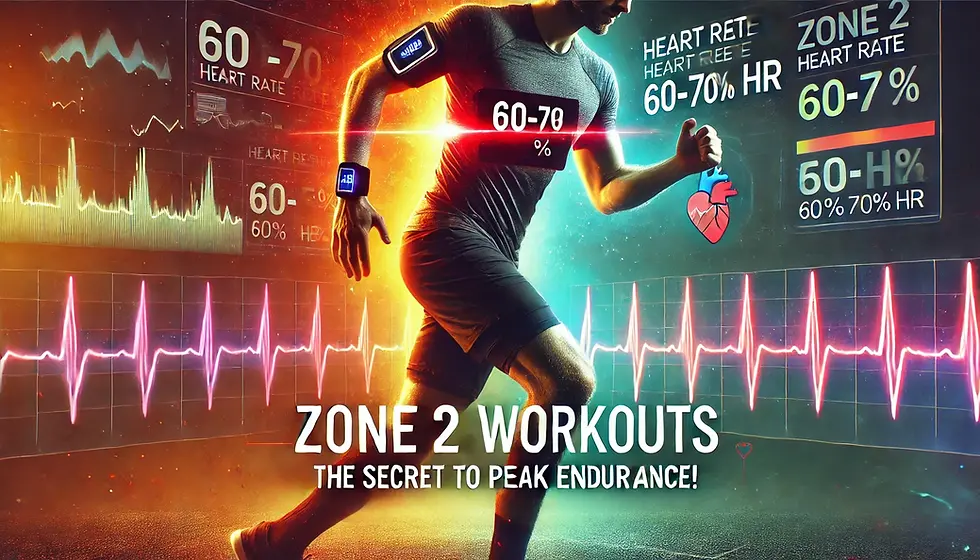How Zone 2 Workouts Will Transform Your Endurance Training and Take You to the Next Level of Fitness
- Athul Satheesh

- Mar 2
- 4 min read
Updated: May 23

Zone 2 workouts are becoming a vital part of any serious endurance training plan. If you are an athlete or someone just starting to focus on fitness, understanding Zone 2 training can help you unlock your full potential. In this article, we will explore the science behind Zone 2 workouts, their benefits, how to perform them effectively, and how to boost your endurance training.
What is Zone 2 Workout?
To appreciate the importance of Zone 2 workouts, you need to know about heart rate zones. Zone 2 is generally defined as 60-70% of your maximum heart rate (HR). In this zone, your body transitions from mainly using glycogen to burning fat, making it crucial for endurance training.
To find your Zone 2 heart rate, first calculate your maximum heart rate using the formula 220 minus your age. For instance, if you are 30 years old, your estimated max HR would be around 190 beats per minute. Thus, your Zone 2 range would be approximately 114 - 133 beats per minute.
Wearing a heart rate monitor while working out can ensure that you stay within this zone. Research shows that training in Zone 2 can lead to a 20-30% increase in your endurance over time.
Free Zone 2 Heart Rate Calculator
Benefits of Zone 2 Workouts

Zone 2 workouts provide a host of benefits that can enhance your overall fitness. Here are some key advantages:
Improves Aerobic Endurance: Training in this zone increases your body's efficiency in using oxygen, which is fundamental for improving performance in longer races and events, such as half-marathons and triathlons.
Enhances Fat Metabolism: Zone 2 workouts primarily use fat as an energy source. A study revealed that athletes training in this zone burned 30-40% more fat compared to other workout intensities, making it ideal for weight management.
Strengthens the Cardiovascular System: Regularly working out in Zone 2 can improve your heart's efficiency, allowing it to pump blood more effectively. This can lower resting heart rates by 5-10 beats per minute.
Boosts Mitochondrial Efficiency: More mitochondria mean your cells can produce more energy. This makes you feel less fatigued during longer workouts.
With a broad range of benefits, the argument for incorporating Zone 2 workouts into your routine is strong!
How to Perform Zone 2 Workouts
Now that you know what Zone 2 training is and understand its benefits, let’s discuss how to effectively perform these workouts.

Exercises to Consider:
Brisk Walking: Ideal for beginners. Maintain a steady pace and track your heart rate to stay in Zone 2.
Jogging: A light jog helps maintain your heart rate while increasing your endurance.
Cycling: Whether outdoors or on a stationary bike, this activity can be a fun way to get into Zone 2.
Rowing: Engages multiple muscle groups and offers a terrific cardio workout.
Swimming: A low-impact option that allows for effective Zone 2 training with minimal joint stress.
Tracking Intensity
Using a heart rate monitor is crucial. Keep your heart rate in the designated range, taking quick breaks if necessary to maintain the right intensity.

Duration & Frequency
Consistency is essential for Zone 2 workouts.
Recommendations:
Beginners: Start with 20-30 minutes of Zone 2 training, 2-3 times a week.
Advanced Athletes: Increase to 60-90 minutes, aiming for 3-5 sessions weekly.
Including rest days or lower-intensity workouts will help boost recovery and performance.
Comparison with HIIT
Zone 2 training is about maintaining a steady heart rate, while High-Intensity Interval Training (HIIT) focuses on short bursts of max effort followed by recovery.
Distinct Benefits of Zone 2: This method enhances endurance and fat burning without the injury risks associated with excessive intensity.
Distinct Benefits of HIIT: HIIT offers quicker improvements in speed and power but can lead to more fatigue and greater recovery demands.
Learn how incorporating cold showers post-workout can accelerate recovery and enhance the benefits of your endurance training
Common Mistakes
Be aware of these common pitfalls when adopting Zone 2 workouts:
Excessive Intensity: Training too hard can push you out of Zone 2, diminishing the benefits.
Improper Tracking: Not using a heart rate monitor can hinder the effectiveness of your training.
Inconsistent Training: Consistency is crucial to see results — sporadic efforts will not yield significant improvements.
FAQs
Is Zone 2 training effective for weight loss?
Absolutely! Zone 2 workouts effectively burn fat, making them a great choice for weight loss.
Can I build muscle with Zone 2 training?
While the main focus is on endurance, complementary strength training during your week can lead to some muscle gain.
What results should I expect?
After several weeks of consistent Zone 2 training, many experience enhanced endurance, improved aerobic capacity, and better overall fitness.
Elevate Your Training
Incorporating Zone 2 workouts into your endurance training can truly elevate your fitness journey. With benefits such as improved aerobic endurance and fat metabolism, this training method is invaluable for both beginners and seasoned athletes.
Invest time in Zone 2 training and watch your fitness soar to new heights!



Comments